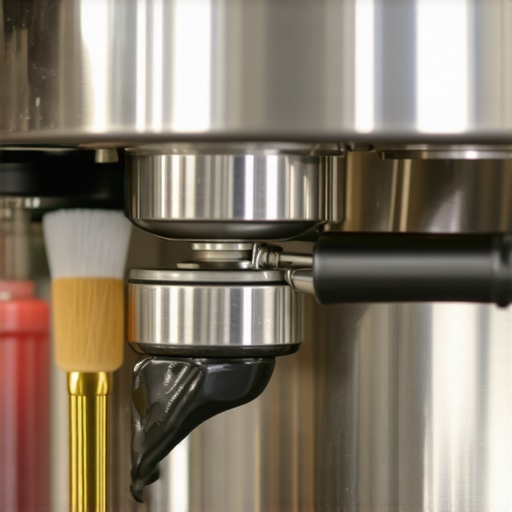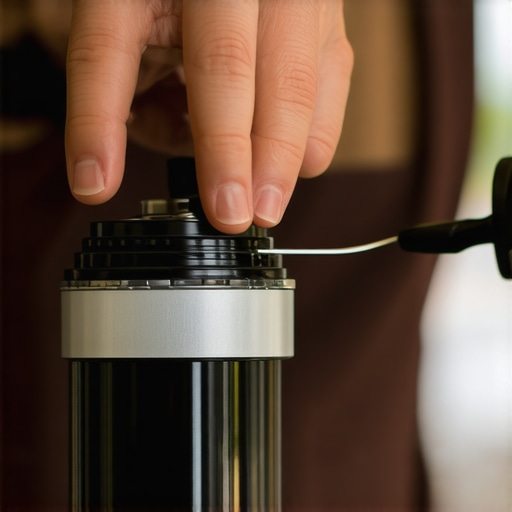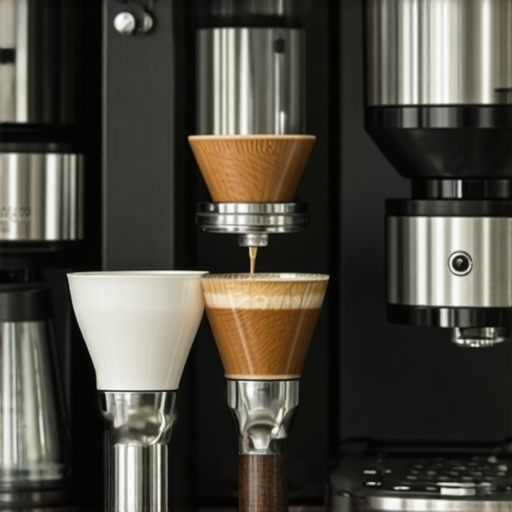How I Fell in Love with My First Home Espresso Machine
It all started on a chilly winter morning when I decided to upgrade my coffee routine. I vividly remember unboxing my first home espresso machine, feeling a mix of excitement and curiosity. As an avid coffee enthusiast, I knew that having a reliable espresso machine would transform my mornings. Over time, I learned that choosing the right machine involves understanding various features like pressure systems, boiler types, and ease of use.
My Experience with Different Types of Espresso Machines
Initially, I experimented with semi-automatic machines, which offered a good balance of control and convenience. Later, I explored fully automatic and super-automatic options, discovering how they simplified the brewing process. I found that a good espresso machine not only improves flavor but also enhances the overall coffee experience at home. Brands like Breville and DeLonghi became my favorites, thanks to their durability and innovative features.
What Makes a Great Home Espresso Machine in 2024?
From my perspective, the ideal espresso machine combines excellent build quality, customizable settings, and reliable performance. With so many options on the market, I paid close attention to customer reviews and expert recommendations, such as those found on trusted sites like CoffeeGeek. In 2024, I believe the best machines also incorporate smart technology for precision brewing, a feature I personally value for consistency.
Why I Switched to a Bean-to-Cup Machine
After years of using traditional espresso machines, I decided to try a bean-to-cup model. This switch allowed me to grind fresh beans right before brewing, significantly elevating my coffee’s aroma and flavor. Plus, I appreciated how these machines simplified maintenance while maintaining top-notch quality. If you’re considering this upgrade, check out the latest reviews on top coffee grinders for perfect home espresso in 2025 to find the best grinder to complement your machine.
What About the Cost? Is It Worth It?
In my experience, investing in a quality espresso machine pays off in the long run. Cheaper models often compromise on temperature stability and durability, which can lead to disappointing results. I found that spending a bit more on a reputable brand ensures better consistency and longevity. For those on a budget, there are excellent entry-level options that still deliver impressive espresso shots. Remember, the perfect cup is about more than just the machine—it’s about your passion and practice.
How Do I Maintain My Home Espresso Machine for Longevity?
Regular cleaning and descaling are essential for keeping your espresso machine in top shape. I schedule weekly maintenance to prevent mineral buildup and ensure optimal performance. Using filtered water also helps extend the machine’s lifespan. I recommend consulting your specific model’s manual and following trusted guides, like those on Espresso Tech Guide, for detailed tips.
If you’re a fellow coffee lover, I’d love to hear about your experiences with home espresso machines. Drop a comment below or share your favorite model! Remember, the right equipment can turn your kitchen into a cozy café, elevating your mornings and making every sip special.
How Can Proper Maintenance Elevate Your Home Espresso Experience?
As an avid home barista, I’ve learned that the longevity and performance of your espresso machine hinge on diligent maintenance. Regular cleaning not only ensures each shot tastes fresh but also prevents mechanical issues that can cost time and money in repairs. Think of your machine as a fine-tuned instrument—neglecting routine care can quickly diminish its harmony and brewing precision.
What Are the Critical Steps to Keep Your Espresso Machine in Top Shape?
Start with daily routines such as wiping down the milk frothing wand and cleaning the brew head to prevent residue buildup. Weekly descaling is equally essential, especially if you live in areas with hard water. Descaling removes mineral deposits that can clog internal components, reducing efficiency and risking damage. For detailed guidance, I recommend consulting trusted sources like Espresso Tech Guide, which provides comprehensive maintenance checklists tailored to different models.
How Do I Choose the Right Cleaning Products and Tools?
Using the correct descaling solutions and cleaning brushes is crucial. Avoid harsh chemicals that may harm the machine’s internal parts; instead, opt for products specifically designed for espresso machines. Soft cloths and non-abrasive brushes help maintain the exterior without scratches. Remember, consistent cleaning extends beyond aesthetics—it directly impacts the quality of your espresso and the machine’s durability.
Have I Considered How Water Quality Affects My Machine’s Health?
Absolutely. Using filtered or bottled water can significantly reduce mineral buildup, which is one of the leading causes of machine malfunction. Regularly changing water filters and monitoring water hardness can make a noticeable difference. For those serious about their coffee, investing in a water testing kit might be worthwhile. This proactive approach ensures your machine operates under optimal conditions, preserving the flavor profile and extending its lifespan.

Is There a Way to Troubleshoot Common Maintenance Issues?
Yes, understanding how to address common problems can save you from unnecessary repairs. For instance, if your espresso starts to taste bitter or sour, it could indicate scale buildup or stale beans. Running a descaling cycle or cleaning the brew path might resolve these issues. Similarly, if the machine leaks water, inspecting seals and gaskets for wear or damage is advisable. Keeping a maintenance log helps track what’s been done and when, ensuring consistent performance over time.
Why Sharing Maintenance Tips Can Help the Coffee Community Thrive?
Sharing your experiences and solutions fosters a knowledgeable community of enthusiasts who value quality and longevity in their coffee gear. Whether you’re a novice or a seasoned expert, exchanging insights on maintenance routines, products, and troubleshooting strategies can empower others to get the most from their investments. If you’re eager to deepen your understanding, exploring comprehensive guides like those on Espresso Tech Guide can offer invaluable tips and expert advice.
Have you faced unique challenges with your espresso machine? Drop a comment below or share your favorite maintenance practices! Remember, regular upkeep is the secret to consistently excellent coffee and a machine that serves you well for years to come.
Embracing the Nuances: The Art of Dialing in Your Espresso for Perfect Results
One of the most rewarding yet challenging aspects of home brewing is mastering the art of “dialing in” your espresso shot. I vividly recall spending countless mornings tweaking grind size, tamp pressure, and extraction time, each adjustment bringing me closer to that elusive perfect cup. Over time, I realized that understanding the delicate balance between these variables transforms the process from mere routine into a mindful ritual.
How Do I Fine-Tune My Grinder for Consistency Over Time?
Consistency is the backbone of great espresso, and this is where my relationship with my grinder deepened. I learned that regular cleaning of burrs and calibration checks are essential—small adjustments that can make a significant difference. Investing in a high-quality grinder and maintaining it diligently ensures that each dose remains uniform, preserving the integrity of my brew. For example, I now check my grinder’s calibration monthly, especially when the seasons change, as humidity can subtly affect bean behavior.
Can Advanced Brewing Techniques Elevate My Home Espresso Experience?
Absolutely. Techniques like pre-infusion—gently soaking the coffee grounds before full pressure—have revolutionized my approach. It allows the coffee to bloom, reducing channeling and enhancing extraction. Implementing this, I noticed a marked improvement in crema richness and flavor complexity. Exploring these methods invites a deeper appreciation for the science behind brewing and fosters a more engaged, thoughtful coffee routine. For those interested, detailed guides on sites like CoffeeGeek provide invaluable insights into advanced techniques.
How Do I Balance Equipment Investment and Skill Development?
This is a nuanced question I often pondered myself. While top-tier equipment can unlock new potentials, I found that honing my barista skills—learning proper tamping, temperature control, and timing—often yields more immediate benefits than simply upgrading hardware. It’s about cultivating a holistic approach, where equipment and technique evolve together. Sharing this perspective, I encourage fellow enthusiasts to focus on skill-building with their current gear before splurging on the latest machines.
What Role Does Coffee Origin and Blend Play in My Daily Ritual?
Over the years, I’ve developed a keen interest in exploring different coffee origins and blends. Each bean tells a story—unique terroirs, processing methods, and roasting profiles. Experimenting with single-origin beans versus blends has enriched my appreciation, revealing subtle flavor nuances and aroma profiles. I often rotate my beans, adjusting my grind and extraction to match their characteristics, which keeps the routine fresh and engaging. For detailed insights, I recommend exploring resources like this guide for selecting beans that complement your equipment and taste preferences.
How Can I Incorporate Sustainability Practices Into My Home Coffee Routine?
Sustainability has become a meaningful part of my journey. From choosing ethically sourced beans to minimizing waste, I strive to align my passion with environmental responsibility. Using reusable filters, composting coffee grounds, and selecting eco-friendly packaging are small yet impactful steps. Additionally, being mindful of water and energy consumption during brewing not only benefits the planet but also enhances my overall satisfaction, knowing I’m making conscious choices. I’d love to hear how fellow enthusiasts integrate sustainability into their routines—share your tips in the comments!

Reflecting on My Coffee Journey: Beyond the Brew
Looking back, my home espresso journey has been a blend of technical learning, sensory exploration, and personal growth. Each cup tells a story—of patience, experimentation, and a deepening appreciation for the craft. It’s a reminder that excellence often resides in the small details, and that passion combined with curiosity can elevate even the simplest daily rituals. I invite you to share your own experiences—what’s been your most valuable lesson or breakthrough? Let’s continue this journey together, one exceptional shot at a time.
Refining Your Technique: The Nuances of Perfecting Espresso Extraction
One aspect that consistently elevates my home brewing experience is understanding the subtle variables that influence extraction quality. Achieving a balanced shot requires meticulous attention to grind size, tamping pressure, and temperature stability. For instance, slight adjustments in grind fineness can dramatically alter flow rate and flavor profile. I have found that investing in a high-precision scale and a calibrated tamper significantly improves consistency. According to coffee scientist Scott Rao, mastering these small but impactful details can transform your espresso into a masterpiece, emphasizing that precision is key in home brewing excellence (Scott Rao’s insights).
Can Advanced Equipment Techniques Unlock New Flavor Dimensions?
Absolutely. Techniques such as pre-infusion and pressure profiling have opened new horizons for me in crafting complex, nuanced espresso shots. Pre-infusion, where water gently saturates the coffee grounds before full pressure, minimizes channelling and enhances extraction uniformity. Pressure profiling involves adjusting pressure during extraction to optimize flavor compounds, a feature increasingly available on high-end machines. Implementing these methods requires understanding your specific equipment’s capabilities and experimenting with parameters. For those eager to explore, I recommend consulting detailed guides on CoffeeGeek, which provide comprehensive tutorials on advanced brewing techniques. These methods demand patience and precision but reward you with richer, more vibrant flavors that elevate everyday coffee routines.
How Do I Balance Equipment Investment with Developing My Barista Skills?
This ongoing dilemma resonates deeply with my journey. While investing in sophisticated machinery can unlock technical possibilities, I’ve learned that honing foundational skills often yields more immediate improvements. Proper tamping, temperature management, and shot timing are skills that, once mastered, maximize the potential of any machine. I advise fellow enthusiasts to focus on skill development with their current setup before contemplating upgrades. Enhancing your palate through sensory training—such as tasting sessions and flavor wheel studies—also deepens your appreciation and discernment. For a comprehensive approach, exploring resources on Espresso Tech Guide offers valuable insights into aligning equipment choices with skill refinement for optimal results.
What Are the Best Practices for Ensuring Long-Term Equipment Reliability?
Beyond routine cleaning, implementing preventative maintenance routines is vital. Regularly checking seals, gaskets, and valves for wear prolongs the lifespan of your machine. Using high-quality water and performing periodic descaling with manufacturer-recommended solutions prevents internal mineral buildup that can impair performance. I also keep a maintenance journal to track cleanings, repairs, and calibration checks, which helps identify patterns and preempt issues. Engaging with community forums and expert guides, such as those at Espresso Tech Guide, enhances my understanding of model-specific nuances. A well-maintained machine not only ensures consistent quality but also provides peace of mind, allowing me to focus on refining my craft rather than troubleshooting technical faults.
How Can I Elevate My Sensory Skills to Detect Subtle Flavor Variations?
Developing a refined palate is arguably the most rewarding aspect of my coffee journey. I dedicate time to taste testing different beans, noting aroma, acidity, body, and aftertaste. Utilizing flavor maps and participating in cupping sessions sharpens my sensory perception. I also experiment with variables like roast level and extraction time to understand their impact on flavor nuances. This heightened awareness enables me to select beans and adjust brewing parameters more intentionally. According to sensory scientist Dr. Ann C. Noble, systematic training and mindful tasting significantly improve flavor detection capabilities (Sensory Science Foundation). I encourage fellow enthusiasts to embrace this ongoing learning process—your appreciation for coffee’s complexity will deepen, and your brewing results will become increasingly nuanced.
Join the Conversation: Share Your Most Advanced Coffee Technique or Insight
Embarking on the path of mastery in home espresso is a continuous adventure filled with experimentation and discovery. I invite you to share your own advanced techniques, insights, or challenges—whether it’s a specific pressure profile you swear by, a unique bean origin that transformed your palate, or a troubleshooting tip that saved your brew. Engaging with a community of passionate enthusiasts accelerates our collective growth and deepens our appreciation for this craft. Remember, the pursuit of excellence is a journey—let’s learn from each other’s experiences and elevate our home brewing to new heights. Feel free to leave a comment below or connect through specialized forums to keep the dialogue vibrant and inspiring.
Things I Wish I Knew Earlier (or You Might Find Surprising)
Mastering the Art of Consistency
One of the biggest revelations in my home espresso journey was how small adjustments—like tweaking grind size or tamp pressure—can dramatically change the flavor. I used to think that quality equipment alone would guarantee perfect shots, but I learned that consistency in technique is equally vital, turning each cup into a work of art.
The Hidden Power of Water Quality
I was surprised to discover how much water plays a role in the taste and longevity of my machine. Using filtered water drastically reduced mineral buildup, leading to better espresso and fewer maintenance issues. It’s a simple change that made a big difference in my daily routine.
Patience Pays Off
Initially, I was eager for instant results, but I soon realized that developing a good espresso routine requires patience and practice. Over time, I honed my skills, and now every shot feels like a small victory—an artful ritual I genuinely enjoy.
The Value of Learning from Others
Joining online communities and reading trusted guides helped me avoid common mistakes. Sharing experiences and tips with fellow enthusiasts accelerated my progress and deepened my appreciation for the craft. It’s amazing how collective knowledge elevates individual skills.
Maintenance is More Than Routine
Regular cleaning and descaling are crucial, but I learned to see maintenance as a way to extend my machine’s life and improve the quality of my espresso. Investing a little time each week keeps my setup performing at its best, turning maintenance into a rewarding part of my coffee ritual.
Resources I’ve Come to Trust Over Time
- CoffeeGeek: This site offers detailed reviews and user experiences that helped me choose the right equipment and troubleshoot issues. It’s a treasure trove for serious home baristas seeking honest advice.
- Espresso Tech Guide: Their comprehensive guides on cleaning, descaling, and maintenance provided me with step-by-step instructions that saved me time and frustration. I recommend it to anyone wanting to prolong their machine’s lifespan.
- Scott Rao’s Insights: The work of Scott Rao opened my eyes to the science behind brewing. His emphasis on precision and attention to detail inspired me to refine my technique and appreciate the complexity of espresso extraction.
Parting Thoughts from My Perspective
Reflecting on my experience, I realize that owning a home espresso machine is about more than just making coffee; it’s about embracing a journey of continuous learning, experimentation, and appreciation for the craft. The most valuable lesson I’ve learned is that even small improvements—whether in technique, water quality, or maintenance—can elevate your coffee routine to new heights. If this resonates with you, I’d love to hear your own stories or tips. Share this with a fellow coffee lover, and let’s keep inspiring each other to brew better every day.

